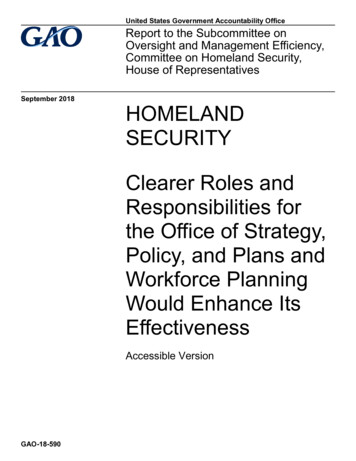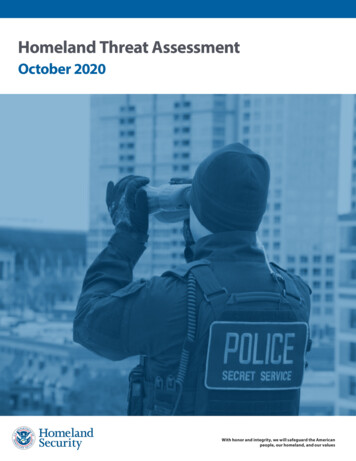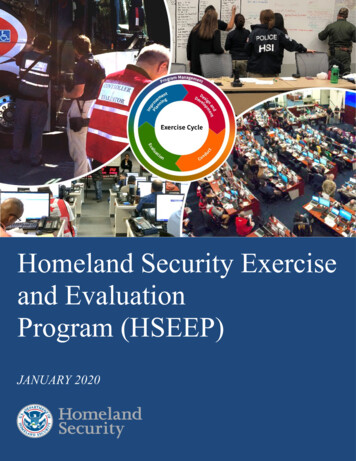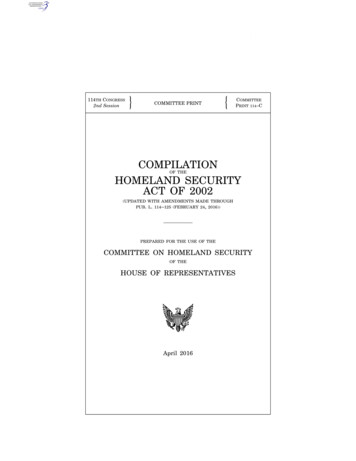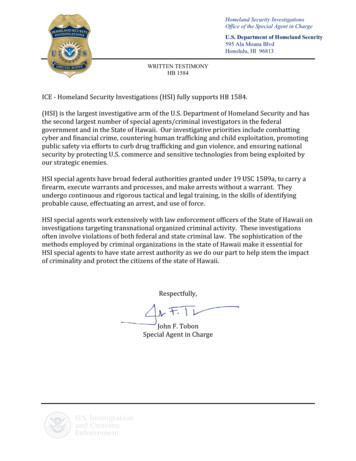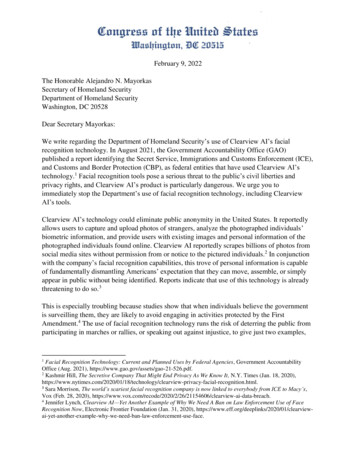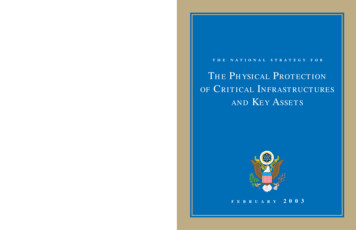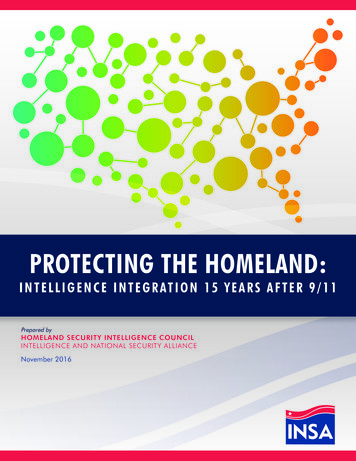
Transcription
PROTECTING THE HOMELAND:I N T E L L I G E N C E I N T E G R AT I O N 1 5 Y E A R S A F T E R 9 / 1 1Prepared byHOMELAND SECURITY INTELLIGENCE COUNCILINTELLIGENCE AND NATIONAL SECURITY ALLIANCENovember 2016
ACKNOWLEDGEMENTSINSA appreciates the efforts of everyone who contributed to the research and production of this white paper:HOMELAND SECURITYINTELLIGENCE COUNCILCaryn Wagner, ChairINSA LEADERSHIPLetitia A. Long, ChairmanChuck Alsup, PresidentBarbara AlexanderGeorge BamfordI N S A S TA F FAmy ChoiLarry Hanauer, Vice President for PolicyAndrew CoffeyRyan Pretzer, Policy and Public Relations ManagerCindy FarkusEnglish Edwards, Marketing and Communications ManagerDennis HuntJoey Dahl, InternGeorge JamesonAaron Lin, InternLaura Manning JohnsonChristina Ma, InternElena Kim-MitchellLaura Wilkinson, InternDon LorenJulie NacosJordan RengaDawn ScaliciJudy SmithTony SpadaroJim SteinerDon Van DuynMegan WoolseyINSA SUPPORTS A HEALTHY PLANETINSA White Papers areprinted onrecycled paperthat is 50%recycled contentincluding 25%post consumerwaste.
EXECUTIVE SUMMARYThe Homeland Enterprise consists of a vast series of formal and informalrelationships between federal departments and agencies; state, local, tribal,and territorial (SLTT) entities; and the private sector. Each of these entities andrelationships – some long established, others newly emergent – contribute to thebody of information that is collected and analyzed to produce the intelligencenecessary to protect the U.S. homeland. INSA’s Homeland Security IntelligenceCouncil (HSIC) conducted interviews with more than 40 experts for theirperspectives on the progress of the Enterprise and its remaining challenges 15years after September 11, 2001, and five years after its first white paper on thetopic. Forgoing a discussion of cyber threat intelligence and defense, this paperhighlights four primary concerns highlights by the interviewees:1. The Office of Director of National Intelligence (ODNI) could have aclearer and more robust role as the coordinating body for homelandintelligence priorities and activities and the integration of homelandintelligence into national intelligence priorities and activities.2. Interagency mechanisms that foster collaboration and information sharingamongst Enterprise partners offer best practices to work across the statutoryand organizational boundaries and should be expanded and strengthened.3. Information sharing efforts with SLTT entities would benefit fromsystematically informing them of current national priorities and informationneeds, streamlining the systems they use to receive federally-providedinformation, and providing a process and mechanism for them to sharerelevant information with federal partners.4. Sharing government information with the private sector must now shifttoward developing a truly reciprocal relationship, which requires theidentification of sharing mechanisms that facilitate an interactive feedbackloop between the government and the private sector and a moreintegrated government approach to meeting private sector requirements toprotect critical infrastructure.Paramount to each of these concerns is a need for solutions founded in theprotection of civil liberties and privacy rights, and as appropriate, providingtransparency that fosters the trust and cooperation of the public in this sharedeffort to protect the people, property and critical systems of the United States.PROTECTING THE HOMELAND 1
INTRODUCTIONThe Intelligence and National Security Alliance (INSA) established the HomelandSecurity Intelligence Council (HSIC) in 2008 to promote understanding of therole of intelligence in the Homeland Enterprise (Enterprise), the successes it hasachieved, and evolving challenges that continue to threaten our nation. TheEnterprise consists of a vast series of formal and informal relationships betweenfederal departments and agencies; state, local, tribal, and territorial (SLTT)entities; and the private sector. Each of these entities and relationships – somelong established, others newly emergent – contribute to the body of informationthat is collected and analyzed to produce the intelligence necessary to protectthe U.S. homeland.In September 2011, INSA published an initial white paper on the topic, Intelligenceto Protect the Homeland,1 which examined the Enterprise’s progress and leadingchallenges 10 years after 9/11. The paper offered 16 recommendations (seeAppendix A) that were principally concerned with strengthening coordination,connectedness, and unity of effort across the Enterprise.The 15th anniversary of 9/11 and the imminent election of a new president presenta timely opportunity to reflect on years of evolving practice and revisit the paper,its recommendations, and the state of the Enterprise. Significant progress in areaslike information sharing between federal and non-federal partners has beentested by evolving threats, particularly homegrown violent extremism inspiredby the Islamic State (ISIS/ISIL) and other overseas extremist organizations. Theactivities of transnational criminal organizations and the ubiquity of threats fromcyberspace have further blurred the boundaries between foreign and domesticthreats and, as a result, between foreign intelligence and homeland intelligence.Integrating both types of intelligence within the Enterprise is essential to protectingthe homeland and strengthening U.S. national security overall. INSA offers thispaper as testament to the strides already made, and the challenges ahead, toenhance intelligence integration across the Enterprise.Intelligence and National Security Alliance (INSA), Intelligence to Protect the Homeland: Taking Stock Ten Years Later and Looking Ahead, September 2011.At http://www.insaonline.org/i/d/a/b/Intelligence to Protect.aspx.12 Intelligence and National Security Alliance www.INSAonline.org
Integrating foreign and homeland intelligence within the Enterprise is essentialto protecting the homeland and strengthening U.S. national security overall.METHODOLOGY, DEFINITIONS,AND SCOPEUsing INSA’s 2011 recommendations as a guide, HSIC members interviewedmore than 40 individuals with current or recent senior federal governmentexperience within the intelligence and national security communities, in bothpolicy making and operational roles. Perspectives from Capitol Hill, state andlocal agencies, the private sector, and nonpartisan research organizations alsowere represented in the interviews. HSIC members also consulted reports fromwithin and out of government, notably those by Business Executives for NationalSecurity (BENS) in January 2015 and March 2016, respectively. HSIC members– many of whom served extensively at senior levels in the Enterprise – developedthis white paper’s recommendations based on themes that emerged from theinterviews and relevant literature.Precise definitions have historically been a problem in discussing homelandintelligence. Consequently, interviews began with the respondents’ viewsof national intelligence as defined in the Intelligence Reform and TerrorismPrevention Act (IRTPA) of 2004. Relating comments to this legal definitionhelped bound the discussion of homeland intelligence and how it fits into thelarger legal framework.National intelligence incorporates both foreign intelligence – collection andanalysis activities directed toward foreign nations and organizations, foreignpersons, or international terrorist activities that are conducted by one of the17 elements of the Intelligence Community (IC) – and domestic intelligence, aterm that is widely used but not defined in statute. Led by the Federal Bureau ofInvestigation (FBI), domestic intelligence targets threats to the United States fromwithin its own borders. Law enforcement intelligence – information collectedand/or analyzed by federal or SLTT law enforcement regarding criminal activityor other threats to the security of U.S. citizens, property and critical infrastructure– draws on different legal authorities to produce intelligence and informationthat can and should inform national intelligence.PROTECTING THE HOMELAND 3
Two assumptions were made to focus this paperand its recommendations:HSIC’s definition of homeland security intelligence (whichwe now refer to as “homeland intelligence”) from INSA’s2011 paper was “information that upon examinationis determined to have value in assisting federal, state,local, and tribal and private sector decision makersin identifying or mitigating threats residing principallywithin U.S. borders.” Some interviewees contended thedistinction of threats residing principally within the UnitedStates was unnecessarily narrow, since external threatsto the homeland would also be considered homelandintelligence, but virtually all agreed that homelandintelligence was a subset of national intelligence and thatit encompassed more than terrorism.Homeland intelligence is most effective when itincorporates foreign and domestic intelligence andinformation from non-intelligence agencies that respondto the full range of national intelligence requirements.Not only is the Intelligence Community’s informationuseful to SLTT and private sector partners, but informationfrom those partners can be useful to the IC on a variety ofissues. The desired end state for the intelligence and lawenforcement communities is to bridge the operational andstatutory divide in ways that respect each organization’sauthorities and protect civil liberties while still deliveringactionable intelligence to Enterprise customers.4 Intelligence and National Security Alliance www.INSAonline.org1.As the statutory backbone of theIntelligence Community and intelligenceactivities in support of homeland security, theIRTPA was an extraordinarily complex pieceof legislation. More than 10 years later, manyobservers would say it largely accomplishedwhat it was designed to do. Although IRTPAmay have shortcomings or have producedunintended consequences, Congress hasshown little interest in undertaking additionalbroad reform efforts. INSA nonethelessstrongly urges the incoming Administrationand the next Congress to review IRTPA andother intelligence statutes, regulations, andguidelines for consistency and to clarify theroles, responsibilities, and authorities of thevarious elements of this complex architecturefor homeland intelligence. Much of this clarificationcan be done within the executive branch, althoughsome minor legislative changes may be required.2. The cyber domain is an essential component ofhomeland security and homeland intelligence. Itserves as an attack vector from which domestic andforeign adversaries can threaten utilities, financialsystems, and other critical infrastructure sectors,as well as steal sensitive government, proprietary,and personal data. It is also the primary means ofsharing information about cyber and non-cyberthreats between Enterprise partners. Ensuring securityof the cyber domain is of critical importance andimmensely complex. Accordingly, cybersecurity asit relates to homeland security and the intelligenceto support it demands a distinct evaluation anddiscussion, which is beyond the scope of thispaper. This paper’s recommendations should beviewed as complementary to the numerous linesof efforts already under way to synthesize cyberthreat information and share actionable cyber threatintelligence with partners across the Enterprise.
OPERATING ACROSS AUTHORITIES:BRIDGING THE TITLE 50 DIVIDEMany of the topics and concerns this paper addresses share an underlyingdynamic—the need to operate effectively and legally across statutory boundariesbetween the activities of foreign-focused intelligence agencies and those ofthe more blended elements of the Homeland Enterprise. Because intelligenceactivities are governed by Title 50 of the U.S. Code, federal departments andagencies not explicitly charged with national security or intelligence missionsare known as “Non-Title 50” partners.2 In the homeland sphere, maximizinginformation and intelligence integration requires a mix of traditional members ofthe national security community, such as the Department of Homeland Security’s(DHS) Office of Intelligence and Analysis (I&A), US Coast Guard Intelligence, andFBI; non-Title 50 components of DHS that possess security-related information,such as Customs and Border Protection (CBP) and Immigration and CustomsEnforcement (ICE); and representatives from other non-Title 50 organizationssuch as the Departments of Commerce, Transportation, and Health and HumanServices (HHS). (See chart below.) To achieve fuller integration and coordinationof homeland intelligence activities, interagency processes and mechanisms tohelp partners operate across these boundaries are increasingly necessary.As the lines between foreign and domestic intelligence blur, and as it becomesclear that information gathered by law enforcement officials at all levels can bea critical piece of the overall intelligence threat picture, it is important to developsystems and processes to enable that sharing while preserving civil rights andliberties. Effective Homeland Intelligence will require leadership that can provideguidance for planning and coordination; mechanisms that offer meaningful,reciprocal and legal engagement amongst partners; channels that allow timely,two-way sharing of information; and training and oversight to ensure theprotection of civil rights and civil liberties. The following sections will addresseach of these needs.EXAMPLES OF TITLE 50 AND NON-TITLE 50 ENTITIESOrganizations with Title 50 intelligence authorities must work with a broad range of non-Title 50 partners, including other components of the same Federal agency.Examples of Title 50 OrganizationsExamples of non-Title 50 PartnersCentral Intelligence Agency (CIA)Centers for Disease Control (CDC)Defense Intelligence Agency (DIA)Department of Health & Human Services (HHS)National Security Agency (NSA)Department of Transportation (DOT)Department of State – Bureau of Intelligence andResearch (INR)Department of State – Rest of DepartmentDepartment of Treasury – Office of Intelligence andAnalysis (OI&A)DHS – Rest of Department, including:Department of Homeland Security (DHS) Office of Intelligence and Analysis (OI&A)Department of Treasury – Rest of Department Customs and Border Protection (CBP) Transportation Security Administration (TSA) U.S. Secret Service (USSS)“Non-Title 50” (NT-50) departments and agencies are those federal departments and agencies not listed as elements of the Intelligence Community (IC) inTitle 50 of the United States Code or Executive Order 12333, United States Intelligence Activities (as amended July 30, 2008).2PROTECTING THE HOMELAND 5
INCORPORATING THE HOMELANDINTO NATIONAL INTELLIGENCEPLANNINGWho should provide strategic leadership of homeland intelligence?Respondents expressed consensus (though not unanimity) that the Director ofNational Intelligence (DNI) should assume responsibility for this problem. Noother official has the stature or the mandate to do so, and the role of theDNI is already one of coordination and integration of agencies with disparateauthorities and missions. (It is important to note that we are not proposing theDNI in any way direct or task non-Title 50 organizations, but rather that he, hisstaff and elements of the IC work with them to develop systems and proceduresto allow effective and appropriate partnership to take place.)In 2004, the 9/11 Commission recommended introduction of a DeputyDirector for Homeland Intelligence, reporting to the DNI. Congress did notimplement this recommendation in IRTPA, nor did the ODNI create this positionon its own, although some observers maintain that the proposal remains valid.BENS, for example, declared in its January 2015 report, “The absence of adesignated domestic IC lead needs to be addressed.”3 Even if future DNIs fail tocreate a deputy-level position, a requirement still exists for a focal point on theDNI staff with sufficient seniority to break down stovepipes and bring differentconstituencies to the table.INSA believes an appropriately senior position on the ODNI staff would enablethe ODNI to:1. Set and prioritize requirements for homeland intelligence collection andanalysis;2. Ensure homeland intelligence requirements and products inform nationalintelligence efforts and objectives; and3. Coordinate responsibilities for homeland intelligence activities so as tominimize duplication of effort and encourage each Enterprise member tooperate within the full scope of its authorities.Business Executives for National Security. Domestic Security: Confronting a Changing Threat to Ensure Public Safety and Civil Liberties, January 2015, p. 18.at df.36 Intelligence and National Security Alliance www.INSAonline.org
Since 2011, the DNI has taken the first real steps toimprove integration of homeland intelligence activitiesvis-à-vis the broader IC. A program first piloted in 2011designates Special Agents in Charge (SACs) at a dozenkey FBI field offices as “Domestic DNI Representatives,”charged with coordinating the efforts of Title 50 entitiesoperating in the homeland in a manner similar to therole played by DNI Representatives and embassiesand combatant commands. The DNI also broadenedthe charter of the National Intelligence Manager(NIM) for the Western Hemisphere to include a deputyfocused on homeland intelligence.4 This step was asignificant acknowledgement by the DNI that the IC hadresponsibilities and authorities regarding the homeland,albeit without the stature of a deputy DNI.While these steps were positive, they were modest andmust be built upon. INSA believes that the critical functionof coordinating collection and analysis on threats tothe homeland must be appropriately recognized andresourced. In the absence of a deputy DNI for thehomeland, the DNI should appoint a separate NIM forthe Homeland to serve as the focal point on the DNI Stafffor Homeland Intelligence. Given the critical roles thatDHS and FBI play in collecting and analyzing homelandintelligence, the DNI should consult closely with the DHSUnder Secretary of Intelligence and Analysis and the FBINational Security Branch Executive Assistant Director indefining the focus areas and responsibilities for a newNIM for the Homeland.In addition, the role of the Domestic DNI Representativesin improving the effectiveness of homeland intelligenceremains ill-defined and needs to be clarified, as doestheir relationship to non-Title 50 partners and to a newNIM for the Homeland.These two steps would reinforce the progress towardintelligence integration undertaken by the current DNI.Landmark undertakings to strengthen interoperabilityamongst IC components – such as the IntelligenceCommunity Information Technology Environment (IC ITE)– are only beginning to take hold. Over time, the benefitsto national intelligence should prove substantial andlasting, with the Enterprise a major benefactor.Even after these steps are taken, much work remains tofully integrate homeland intelligence into the frameworkfor national intelligence. A substantial segment ofinterviewees expressed a desire to see homelandintelligence collection and analysis requirementsbetter coordinated. A preponderance of that segmentidentified the ODNI as the most logical focal point forsetting priorities and requirements relevant to homelandintelligence, which would seem to be an appropriateresponsibility for a Homeland NIM. ODNI’s newlyinstituted Homeland Threat Framework provides a basisfor identifying and prioritizing threats, as well as relevantcollection requirements and analytic priorities for ICagencies. The ODNI should present the requirementsthat cascade from the identified priorities in the ThreatFramework as an addendum to the National IntelligencePriorities Framework (NIPF), which is designed to supportthe foreign intelligence mission. The Threat Frameworkcould similarly be used to support the work of theDomestic DNI Representatives in prioritizing and aligningthe work of IC elements across the United States, andin guiding their engagement with non-Title 50 partnersboth in and out of government. This framework couldalso inform the development of a dedicated Program ofAnalysis to guide members of the Enterprise and the ICin their efforts to focus and deconflict analysis on priorityhomeland intelligence issues.INSA recommends that in addition to a separate NIM, theDNI designate a National Intelligence Officer (NIO) whocould orchestrate homeland-related analysis requirementsand responsibilities and work with the elements of theEnterprise (on a voluntary basis for those non-Title 50organizations) to develop a Program of Analysis for theHomeland. Building on the identified priorities of theFramework, this work could also inform the developmentof a National Intelligence Estimate (NIE) to address keysecurity threats that impact the homeland. An NIE,which would represent the consensus of the IntelligenceCommunity, would be a landmark effort to document andanalyze—in one place—the Homeland threat picture.The NIE’s analysis could be used to inform both policiesto improve homeland security and future budget prioritiesfor intelligence and non-intelligence agencies.NIMs develop and oversee collection and analysis strategies for designated issue areas. As the DNI web site explains, “Appointed by the DNI, NIMsserve as the principal substantive advisors on all or specified aspects of intelligence related to designated countries, regions, topics, or functional areas.NIMs provide a single voice to policymakers to orient and guide collection and analytic activities to satisfy customers’ information needs. See Office ofthe Director of National Intelligence, “Intelligence Integration – Who We Are,” web site. Available at ntelligence-integration-who-we-are.4PROTECTING THE HOMELAND 7
INTERAGENCY EXEMPLARSOverall, interviewees from across the Enterprise expressed a sense of progressin interagency collaboration and cooperation. Stakeholders are recognizing thepower of pooling information, authorities, and resources against a problem.Many viewed the National Counterterrorism Center (NCTC) as a model forfederal-level interagency coordination and information sharing. Additionally,the FBI-led Joint Terrorism Task Forces (JTTFs), which are present in 104 cities,were praised for meaningful integration of federal and SLTT partners into FBIcounterterrorism investigations. The Criminal Intelligence Coordinating Council(CICC) was cited by several interviewees as an organization that could playa bigger part in working with NCTC and other federal partners to enhanceinformation sharing. Fusion Centers operated by state and local entities wererecognized as critical nodes within a complex, national network that alsoincludes other decentralized organizations like the JTTFs and High IntensityDrug Trafficking Areas (HIDTA) Program. Since INSA’s last report in 2011,interviewees were more unified in their support of Fusion Centers, focusingmore on how to take them to the next level rather than debating whether theyshould exist at all.F U S I O N C E N T E R S : TA K I N G T H E M T O T H E N E X T L E V E LEach Fusion Center—formed and maintained by law enforcement or publicsafety agencies in states or major urban areas—serves as the primary focalpoint within a jurisdiction for the receipt, gathering, analysis, and sharingof threat-related information among public safetyand security partners, including law enforcement,fire services, emergency responders, public healthofficials, critical infrastructure owners, and the privateFederal partners must invest insector. Fusion Centers have helped authorities instates and major urban areas to fulfill specific rolesbuilding deeper relationshipsand share information in an effort to address gapswith Fusion Centers andidentified in the wake of the 9/11 attacks.continue to provide support inthe form of deployed personnel,training programs anddedicated grant funding.8 Intelligence and National Security Alliance www.INSAonline.org
the FBI has little permanentpresence in Fusion Centers,DHS has multiple personnelworking in states and urbanareas who are not assigned tothe local Fusion Center, andprivate sector participation isminimal, varying widely fromlocation to location.As Fusion Centers continue to mature and fill the stateand local niche within the Enterprise, they have developedrobust inter-organizational networks vertically, with federalpartners and front-line safety and security personnel,as well as horizontally across jurisdictions nationwide.Numerous examples have emerged illustrating the valueof a decentralized network that can rapidly disseminateinformation to and from front-line law enforcementand other public safety professionals in jurisdictions– large and small – across the nation. While many ofthese success stories are affiliated with non-terrorismrelated criminal activities ranging from human anddrug trafficking to apprehension of murder suspects, thenetwork can be leveraged on a daily basis by intelligenceorganizations across all levels of government seeking todisrupt terrorism-related activities or to determine suchactivities’ connections to their jurisdictions.5Despite considerable progress across the nationalnetwork, the maturity and effectiveness of FusionCenters varies considerably, and some Fusion Centersstruggle to fully integrate state and federal players andto penetrate organizational and cultural barriers betweenagencies. The need for integration extends beyond simplyconnecting databases and sharing digital information;partners across all levels of government still need to fullyembrace the “need to share” mentality that encompassesdigital and human networks.In order for Fusion Centers to move to what somedescribed as “Fusion Center 2.0,” Fusion Centers needrelationships and communication with other FusionCenters to ensure horizontal sharing, as well as a strongfederal presence to facilitate vertical sharing. Currently,It is also important to improvetheconnectionbetweenFusion Centers and localprivate industry, in particularwith the owners and operatorsofcriticalinfrastructure.Indeed, given the nationwidepresence of Fusion Centerswith access to federal, state, and local threat information,they are ideally suited to serve as the focal point for federalengagement with private sector infrastructure operators.One of the challenges Fusion Centers continue to faceis the difficulty of establishing an analytic capability.Fusion Centers, many of which are small to begin with,experience high personnel turnover at the analyst andsenior leadership levels, hampering analytic progressand diminishing institutional knowledge. At its most basic,this is a resource challenge. As federal grant fundingdiminishes, jurisdictions are actively seeking to retaintheir Fusion Centers through other funding vehicles thatrequire an “all hazards” focus on local public safety issuesother than terrorism. Such a change in focus requiresstaff with training, skills, and experience related to suchlocal issues, which further distances fusion centers fromthe national Homeland Enterprise.Part of the value proposition of Fusion Centers is theability to produce intelligence products that add valuewithin their jurisdictions while also contributing tofederal partners and others in the Enterprise. In order todo this, federal partners must invest in building deeperrelationships with Fusion Centers and continue to providesupport in the form of deployed personnel, trainingprograms, and dedicated grant funding. By continuingfederal investment in the national network, federalagencies can help build stable partnerships at the stateand local level among traditional and non-traditionalsafety and security partners, and enhance their ability toleverage the network by tapping into localized expertiseand resources spread across the Nation.See, for example, DHS, “Fusion Center Success Stories,” web site, July 23, 2015. At 5PROTECTING THE HOMELAND 9
TASK FORCES: A MODELFOR NON-TRADITIONALINTELLIGENCE ISSUESOrganizations with a stake in homeland issueswould need to develop relationships andrepeatable processes to facilitate the use of jointtask forces when appropriate.F O R M I N G TA S K F O R C E SSeveral interviewees shared examples of working relationships and bestpractices that could promote collaboration – particularly by enablingorganizations governed by disparate legal authorities to deepen missionunderstanding, strengthen operational support, improve collection andanalysis, and enhance responsiveness to customer and stakeholderrequirements. Agencies should expand and routinize the creation of taskforces that assemble personnel from diverse stakeholder organizationsto focus on a common problem. Such ad hoc task forces can draw, asneeded, on intelligence and law enforcement agencies at the federal, stateand local levels, as well as on private sector officials, to ensure that theorganization has the information and authorities to address the challengeat hand. Task forces can be established on a permanent basis, as has beendone by NCTC and the Joint Interagency Task Force-South (JIATF-S), or on atemporary basis to deal with a specific and time-limited problem, such as aninteragency task force established to address the surge in unaccompaniedminors crossing the U.S. border illegally in 2014. (See sidebar.)While such interagency mechanisms offer interoperability across numerousstatutory and organizational boundaries, interviewees cautioned that theycannot be created for every issue. Such an approach is costly, inefficient,and inflexible and must be based on a careful assessment of the purpose,mission, and most effective mix of Title 50, non-Title 50, and non-Federalparticipants
to the homeland would also be considered homeland intelligence, but virtually all agreed that homeland intelligence was a subset of national intelligence and that it encompassed more than terrorism. Homeland intelligence is most effective w

